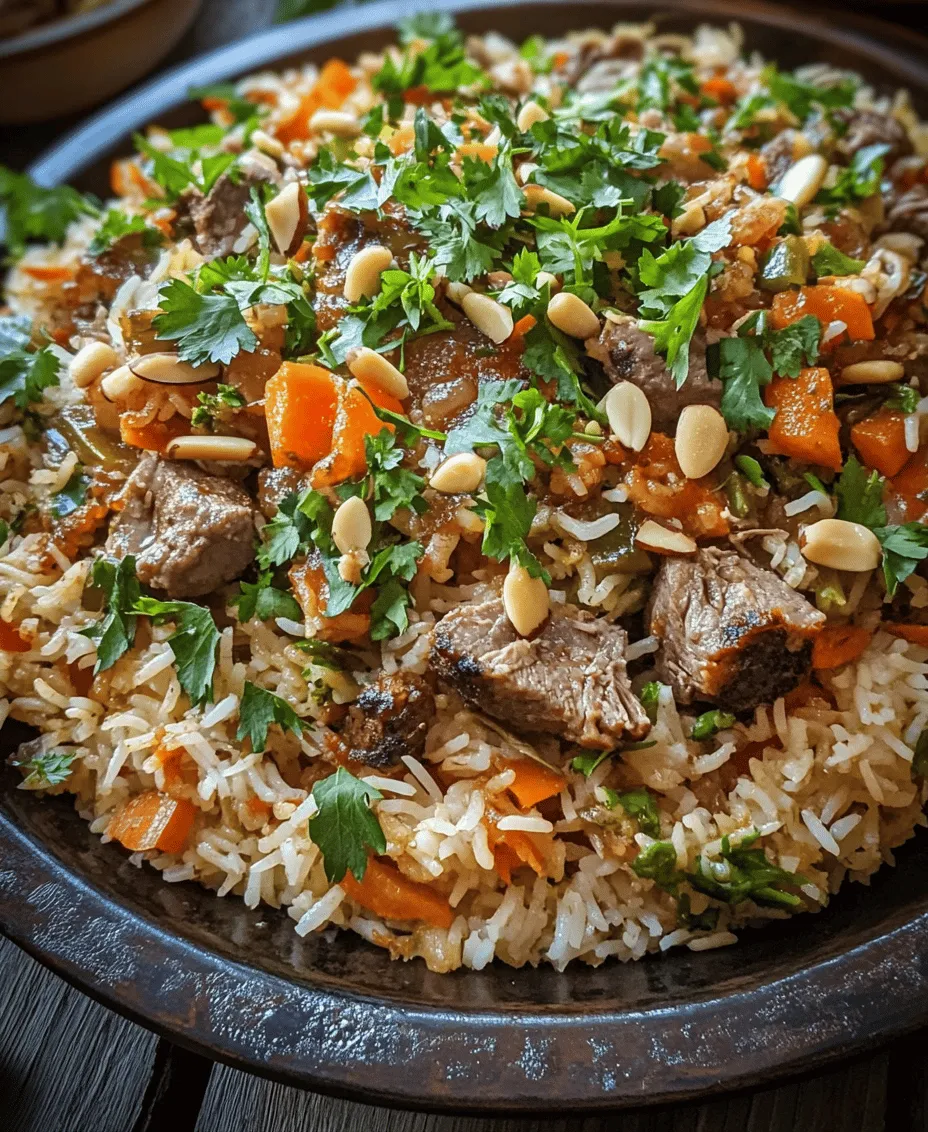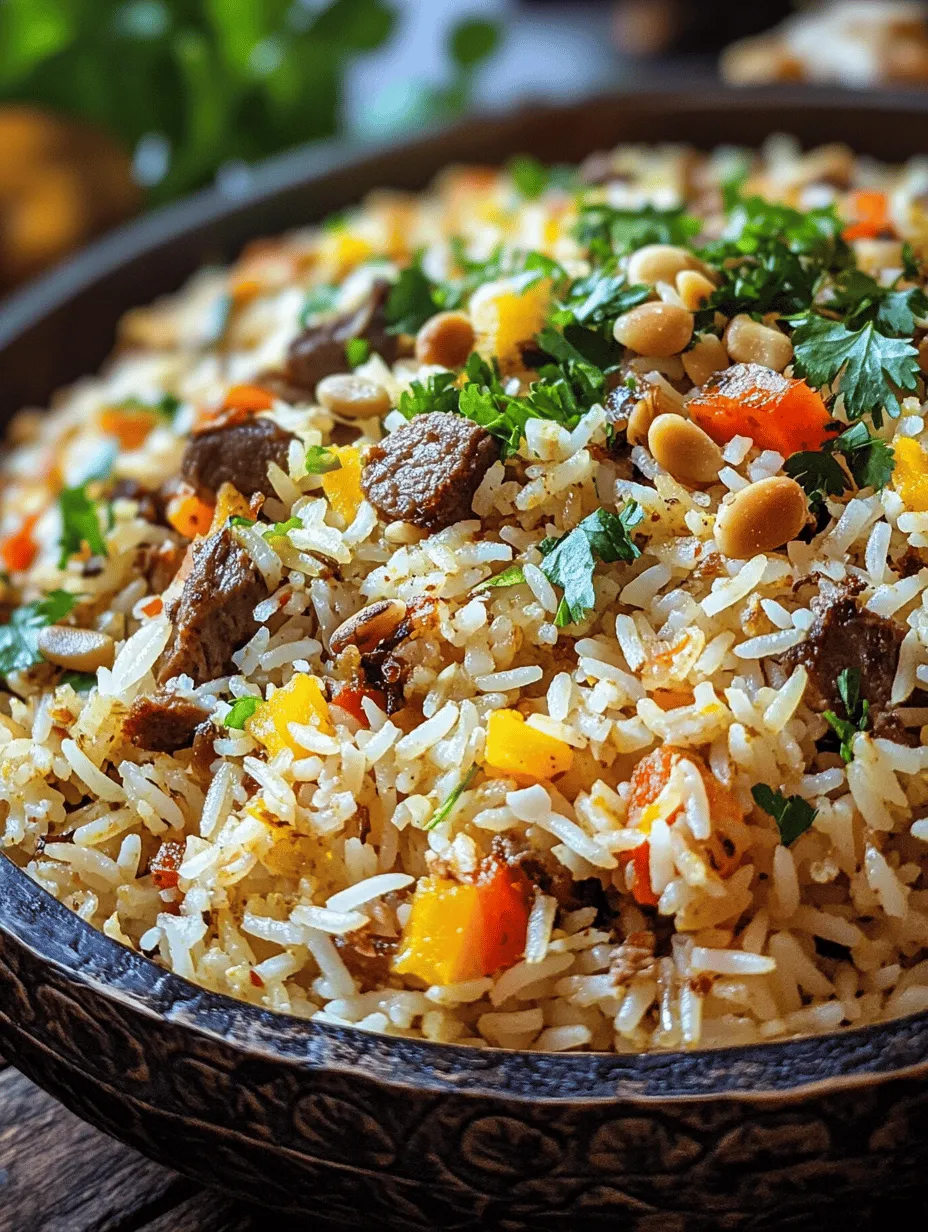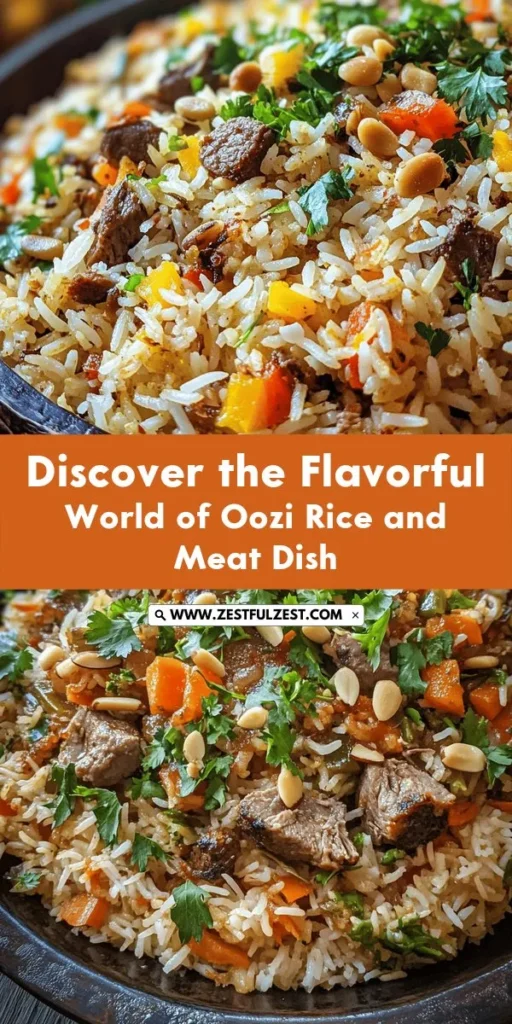Introduction
Embarking on a culinary journey to the Middle East can be rewarding, especially when you encounter the aromatic and flavorful dish known as Oozi. This traditional recipe combines fragrant basmati rice with succulent meat, a medley of vegetables, and a delightful mix of spices, creating a dish that’s not only satisfying but also packed with cultural significance. The vibrant flavors and textures make Oozi a beloved choice for gatherings and special occasions, often served as a centerpiece during festive celebrations.
Originating from the Arabian Peninsula, Oozi has evolved into various regional adaptations, each adding its unique twist while maintaining the essence of the dish. The fragrant aroma of spices wafting through the air and the colorful presentation of rice and meat are sure to impress anyone at the dining table. In this article, we will explore the origins of Oozi, its unique flavors, and provide a step-by-step guide to preparing this delightful meal, ensuring that you can recreate it in your own kitchen with ease.
The Cultural Significance of Oozi
Exploring the Roots of Oozi
Oozi, sometimes referred to as “Uzzi,” has deep roots in Middle Eastern cuisine, primarily found in countries such as Saudi Arabia, Jordan, Lebanon, and Iraq. The dish is believed to have been inspired by the Persian influence in the region, adapting over centuries to become a staple in many households. Traditionally, Oozi was prepared for significant events, such as weddings and religious celebrations, reflecting the importance of community and sharing in Middle Eastern culture.
Understanding its Historical Context
Historically, the preparation of Oozi was a labor-intensive process, often involving the entire family. Preparing the meat, marinating it with spices, and cooking the rice would be a communal effort, showcasing not only the culinary skills of the cooks but also the bonds of family and friendship. Though modern cooking techniques have simplified the process, the spirit of togetherness and the communal enjoyment of food remain central to the experience of enjoying Oozi.
Oozi in Middle Eastern Celebrations
Today, Oozi continues to be a popular dish served during special occasions such as Eid, Ramadan, and family gatherings. The dish is often accompanied by a variety of side dishes, including salads, yogurt, and pickles, enhancing the dining experience. Its rich flavors and satisfying texture make it a favorite among both adults and children, ensuring that it holds a special place in the hearts and stomachs of many.
Ingredients Overview
Essential Components of Oozi
To create a delicious batch of Oozi, you’ll need a selection of key ingredients that come together to create its signature flavor profile. The primary components of Oozi include:
1. Basmati Rice: The heart of the dish, basmati rice is known for its long grains and aromatic qualities. It absorbs flavors well and pairs beautifully with the meat and spices.
2. Meat: Traditionally, lamb or chicken is used, providing a rich and savory flavor. However, beef can also be an excellent alternative, depending on your preference.
3. Spices: A blend of spices, such as cumin, coriander, cinnamon, and cardamom, is essential for achieving the distinctive flavor of Oozi. Each spice contributes to the aroma and depth of the dish.
4. Vegetables: Chopped vegetables, such as carrots, peas, and bell peppers, add color, texture, and nutrition to the dish.
5. Nuts and Raisins: Toasted nuts, like almonds or pine nuts, and sweet raisins add an unexpected crunch and sweetness, balancing the savory elements of the dish.
Highlighting the Importance of Quality Ingredients
The key to a truly memorable Oozi lies in the quality of the ingredients used. Opt for high-quality basmati rice, fresh meat, and aromatic spices for the best results. When possible, choose organic vegetables and nuts to enhance the overall flavor and nutritional value of the dish. Freshness matters, especially with spices, so consider purchasing whole spices and grinding them yourself for maximum flavor.
Substitutions and Variations for Different Dietary Needs
Oozi is a versatile dish that can be adapted to accommodate various dietary preferences. For a vegetarian version, substitute the meat with a variety of vegetables and legumes, such as chickpeas or lentils, ensuring to maintain the aromatic spices. For a gluten-free option, ensure that any broth used is gluten-free and consider using cauliflower rice in place of basmati rice for a low-carb alternative. This adaptability makes Oozi a delightful dish that can cater to a wide range of tastes and dietary restrictions.
Preparation Steps for Oozi
Preparing the Basmati Rice
The first step in preparing Oozi is to prepare the basmati rice. Start by rinsing the rice under cold water until the water runs clear. This process removes excess starch, preventing the rice from becoming sticky during cooking. After rinsing, soak the rice in water for about 30 minutes. This soaking time allows the grains to absorb water, which helps them cook evenly and results in perfectly fluffy rice.
Once soaked, drain the rice and set it aside. In a large pot, bring water to a boil and season it with salt. Add the soaked rice to the boiling water and cook it until it is about 70% done. Drain the partially cooked rice and set it aside for later use. This precooking technique is essential for achieving the perfect texture in the final dish.
The Art of Cooking Meat to Perfection
Next, it’s time to cook the meat. If using lamb, chicken, or beef, cut it into bite-sized pieces for even cooking. In a large pot or Dutch oven, heat a generous amount of oil over medium heat. Once the oil is hot, add the meat and brown it on all sides. This step is crucial as it develops a rich flavor through the Maillard reaction.
Once browned, remove the meat from the pot and set it aside. In the same pot, sauté chopped onions until they become translucent, then add minced garlic for an additional layer of flavor. Return the browned meat to the pot, adding spices such as cumin, coriander, and cinnamon, allowing them to toast slightly before adding broth or water for moisture. Simmer the meat until it is tender and fully cooked, infusing the broth with the spices’ aromatic qualities.
The Role of Spices in Flavor Development
The spices used in Oozi are not just for flavor; they play a crucial role in defining the dish’s character. The combination of warm spices such as cinnamon and cardamom adds depth and complexity, while cumin and coriander provide a fragrant earthiness. As the meat cooks, these spices meld together, creating a rich and aromatic base that penetrates every bite of rice.
For the best flavor, consider using whole spices and grinding them yourself, as this enhances their potency and freshness. Additionally, allow the spices to bloom in the hot oil before adding the meat, as this will release their essential oils and maximize their flavor.
Incorporating Vegetables for Color and Nutrition
To elevate the dish further, incorporate a mix of colorful vegetables. While traditional recipes may use carrots, peas, and bell peppers, feel free to experiment with seasonal vegetables of your choice. Chop the vegetables into bite-sized pieces and add them to the pot after the meat has simmered for a while. This step not only adds vibrant color to the dish but also boosts its nutritional profile.
Sauté the vegetables alongside the meat for a few minutes until they begin to soften. This allows them to absorb the spices and flavors of the meat, creating a harmonious blend of ingredients. Once the vegetables are tender, they will complement the rice beautifully, making your Oozi not just a feast for the palate but also for the eyes.
Combining Rice and Broth: The Key to Moisture and Flavor
The final step in assembling your Oozi is to combine the rice and the flavorful broth created during the meat and vegetable cooking process. Layer the partially cooked rice over the meat and vegetable mixture in the pot. Gently pour the broth over the rice, ensuring it covers the grains evenly. The broth should be well-seasoned, as it will infuse the rice with flavor during the final cooking phase.
Cover the pot tightly with a lid and reduce the heat to low. Let the Oozi steam for about 20 to 30 minutes, allowing the rice to absorb the broth and become fully cooked. This slow cooking process is vital for ensuring that the rice is fluffy and infused with the rich flavors from the meat and spices.
As the Oozi cooks, resist the urge to lift the lid too often, as this will release steam and disrupt the cooking process. Instead, use this time to prepare any side dishes or garnishes you wish to serve alongside, such as a refreshing salad or yogurt.
In the next part of this article, we will delve deeper into the finishing touches, serving suggestions, and tips for achieving the perfect Oozi every time. Stay tuned to discover how to elevate this aromatic rice and meat delight to new culinary heights.

Toasting Nuts: Enhancing Texture and Taste
Toasting nuts is a simple yet transformative step that elevates the flavor and texture of your Oozi. This process enhances the natural oils within the nuts, releasing a rich, nutty aroma that complements the spices and meat in your dish. Here’s how to do it:
1. Choose Your Nuts: Common choices for Oozi include almonds, pine nuts, and walnuts. These nuts not only add crunch but also bring a distinct flavor to the dish.
2. Dry Toasting Method:
– Place your nuts in a dry skillet over medium heat.
– Stir frequently to ensure even toasting and prevent burning. This should take about 5-7 minutes, depending on the type of nut.
– You’ll know they’re ready when they turn golden brown and release a nutty fragrance.
3. Cooling: Once toasted, transfer the nuts to a plate to cool. This prevents them from continuing to cook in the hot skillet.
Incorporating these toasted nuts into your Oozi not only enriches the dish with flavor but also adds an appealing texture contrast that enhances the overall eating experience.
Final Fluffing and Presentation Techniques
After your Oozi has finished cooking, achieving the perfect fluffy rice is essential for a visually appealing presentation.
1. Let It Rest: Remove the pot from heat and let it sit covered for about 10-15 minutes. This resting period allows the steam to finish cooking the rice and ensures a fluffy texture.
2. Fluffing the Rice:
– Use a fork to gently fluff the rice. This technique helps separate the grains without mashing them, maintaining the integrity of your dish.
– If desired, you can add a little olive oil or melted butter at this stage for extra richness.
3. Layering: For presentation, layer the rice on a large serving platter. Use a spoon to create a slight mound in the center, allowing the meat and nuts to be artfully arranged around it.
4. Garnishing: Finish with fresh herbs, such as mint or parsley, and sprinkle your toasted nuts on top. This not only adds visual appeal but also enhances the dish’s flavor profile.
Serving Suggestions
Ideal Pairings with Oozi
Oozi is a versatile dish that pairs beautifully with various sides, making it perfect for family gatherings or festive occasions. Here are some ideal pairings:
– Stuffed Grape Leaves: These provide a delightful contrast in texture and flavor, complementing the richness of the Oozi.
– Hummus and Pita Bread: The creamy texture of hummus and the soft pita make for a satisfying accompaniment that balances the meal.
Accompaniments: Yogurt and Salad Options
Incorporating refreshing sides enhances the overall dining experience:
– Yogurt Sauce: A simple yogurt sauce with garlic, lemon, and mint can add a cooling element to the dish. Just mix plain yogurt with minced garlic, a squeeze of fresh lemon juice, and finely chopped mint.
– Tabbouleh Salad: This fresh salad made with parsley, tomatoes, bulgur, and a tangy dressing adds brightness and freshness, cutting through the richness of the Oozi.
Creative Serving Styles for Family Gatherings and Festivities
For a memorable presentation during special occasions, consider these creative serving styles:
– Individual Portions: Serve in small bowls or plates for each guest, topped with meat and nuts. This adds a personal touch and makes serving easy.
– Layered Presentation: Create a layered effect by placing rice, meat, and nuts in a clear glass dish. This visually striking presentation showcases the beautiful colors and textures of the ingredients.
Nutritional Benefits of Oozi
Understanding the nutritional benefits of Oozi can enhance your appreciation for this dish. Here’s a closer look at its health aspects:
Analyzing the Health Aspects of Ingredients
1. Protein Source: The meat used in Oozi, typically lamb or chicken, is a rich source of protein, essential for muscle repair and overall body functioning.
2. Carbohydrates: The rice in Oozi provides complex carbohydrates, offering sustained energy. Whole grain rice can be used for added fiber.
3. Nuts: The addition of nuts contributes healthy fats, vitamins, and minerals, making your dish nutrient-dense.
Balancing Protein, Carbohydrates, and Vegetables
Oozi can be a balanced meal when paired with the right sides:
– Vegetable Sides: Incorporating vegetables, whether in the form of a salad or cooked sides, ensures a well-rounded meal with necessary vitamins and minerals.
– Portion Control: Be mindful of portion sizes to maintain a balanced intake, especially since Oozi can be rich in calories due to meat and nuts.
Understanding the Role of Spices in Health
The spices in Oozi, such as cinnamon and cardamom, not only enhance flavor but also offer health benefits:
– Cinnamon: Known for its anti-inflammatory properties, cinnamon can help regulate blood sugar levels.
– Cardamom: This spice aids digestion and has antioxidant properties, contributing to overall health.
Variations of Oozi Around the World
Oozi is a beloved dish that has inspired numerous regional variations, each adding unique twists to the classic recipe.
Different Regional Twists on the Classic Recipe
– Jordanian Oozi: This version often includes a variety of spices and is sometimes served with a rich sauce made from yogurt and herbs.
– Saudi Oozi: Typically features a mix of spices and is often garnished with fried onions, giving it a distinct flavor profile.
Exploring Vegetarian and Vegan Versions
For those who prefer plant-based meals, Oozi can easily be adapted:
– Vegetarian Oozi: Substitute meat with a mixture of lentils and chickpeas for protein. Enhance with colorful vegetables like bell peppers, carrots, and peas.
– Vegan Oozi: Use vegetable broth, and include a variety of nuts and spices to replicate the depth of flavor found in traditional recipes.
Incorporating Local Ingredients for a Personal Touch
Feel free to experiment with local ingredients to personalize your Oozi:
– Local Nuts: Using nuts that are locally sourced can add a unique flavor twist.
– Seasonal Vegetables: Incorporating seasonal produce can make your dish fresher and more vibrant.
Conclusion
Oozi is more than just a meal; it is a celebration of flavors, history, and culture. This aromatic rice and meat delight can be adapted to suit various tastes and dietary preferences, making it a versatile dish for any occasion. By following the steps outlined in this guide, you can bring a piece of Middle Eastern tradition into your home, creating a memorable dining experience for family and friends. Embrace the rich flavors and scents of Oozi, and enjoy the process of cooking this beloved dish. Whether you stick with the classic recipe or explore creative variations, Oozi will undoubtedly become a cherished addition to your culinary repertoire, inviting warmth and joy into your kitchen and your gatherings.



